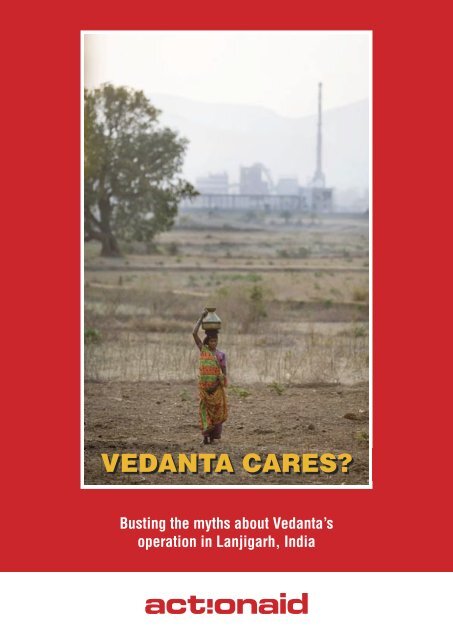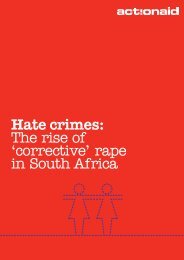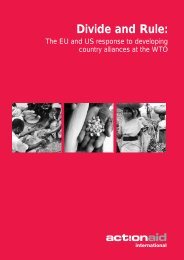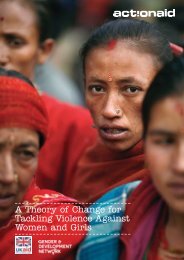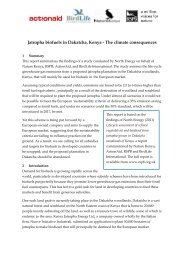Vedanta Cares? - ActionAid
Vedanta Cares? - ActionAid
Vedanta Cares? - ActionAid
Create successful ePaper yourself
Turn your PDF publications into a flip-book with our unique Google optimized e-Paper software.
VEDANTA CARES?<br />
Busting the myths about <strong>Vedanta</strong>’s<br />
operation in Lanjigarh, India
Background<br />
For generations, indigenous people from the<br />
Dongria Kondh, Kutia Kondha and Jharania<br />
Kondha tribal groups have lived in the lush forests<br />
of Niyamgiri mountain, in Kalahandi District, Orissa,<br />
India, by foraging in the forests, raising chickens and<br />
growing vegetables and rice.<br />
Now, local tribal families are living in fear for their<br />
future due to the arrival of a combined bauxite<br />
mining and alumina refinery project in the heart<br />
of their ancestral domain by an Indian subsidiary<br />
of the UK mining and metals company, <strong>Vedanta</strong><br />
Resources plc.<br />
Over the past three years, villagers claim to have<br />
been involuntarily displaced from their homes and<br />
refused compensation for their lost land. Their<br />
protests about the threat the project poses to the<br />
forests they depend upon for their livelihoods<br />
have been repeatedly ignored by officials and the<br />
company. They also have deep concerns about the<br />
impact of mining on Niyamgiri mountain, from which<br />
they derive many of the religious beliefs and cultural<br />
practices that define their tribal identity.<br />
The problems began following the signing of a<br />
memorandum of understanding between the<br />
Government of Orissa and Sterlite Industries (India)<br />
Ltd, a subsidiary of <strong>Vedanta</strong> Resources plc, for<br />
establishing a bauxite mine on the plateau atop<br />
Niyamgiri, as well as an associated alumina refinery<br />
plant at the foot of the mountain, near the town of<br />
Lanjigarh. This was followed by an official agreement<br />
signed on the 5 th of October 2004 between the Orissa<br />
Mining Corporation (OMC) and Sterlite Industries<br />
for the purpose of mining of bauxite reserves at<br />
Lanjigarh.<br />
The company plans to mine over 1 million tonnes<br />
of bauxite a year from reserves within Niyamgiri<br />
mountain. Official studies have suggested that this is<br />
likely to lead to massive deforestation on the slopes,<br />
the destruction of protected local ecosystems rich in<br />
biodiversity, and the disruption of key water sources<br />
that supply springs and streams on the surrounding<br />
hillsides and feed two rivers which irrigate large<br />
areas of farmland in southeast Orissa 1 .<br />
In addition to the proposed mine, <strong>Vedanta</strong> has<br />
already constructed a huge alumina refinery plant<br />
near the town of Lanjigarh, and is now digging<br />
‘ponds’ to hold the toxic waste that the factory will<br />
produce. This plant and associated perimeter wall<br />
and feeder road has been the source of major conflict<br />
with local villagers, who claim that homes and farms<br />
have been bulldozed without due consultation or<br />
compensation.<br />
In response to these developments, villagers from<br />
the surrounding area have been organising in evergreater<br />
numbers to protest against the company<br />
and are gaining support locally, nationally and<br />
internationally. At meetings from village to district level,<br />
local people have been condemning the <strong>Vedanta</strong><br />
development and planning how to respond.<br />
On May 16, 2006, a huge meeting was held in<br />
Lanjigarh where 10,000 mostly indigenous people<br />
from the affected districts of Rayagada and Kalahandi<br />
unanimously opposed the construction of the<br />
refinery. The women’s network is particularly strong.<br />
1 These include a 2006 report by the Government-run Wildlife<br />
Institute of India entitled “Studies on Impact on Forests of Proposed<br />
Lanjigarh Bauxite Mining on Biodiversity including Wildlife and its<br />
Habitat”, and a report released by the Supreme Court of India’s<br />
Central Empowered Committee in September 2005.<br />
Busting the myths about <strong>Vedanta</strong>’s operation in Lanjigarh, India 3
On March 1, 2007 local women gathered under the<br />
banner of the Adim Adhikar Surakshya Manch in a<br />
clearing near Bijapur to voice their concerns. The<br />
meeting was witnessed by British journalist Stuart<br />
Freedman who writes:<br />
“Frail looking tribal women take the microphone<br />
in turn and address the overwhelmingly female<br />
audience of perhaps several thousand squatting<br />
cross-legged under the midday sun. Some have<br />
walked 25 kms just to be here. The women’s shrill,<br />
weak voices cause the microphone to squeal and<br />
pitch but the messages are clear…”<br />
The company is aware that the project has sparked<br />
protests, but has not appeared overly concerned<br />
by them. “As with all large developments, there are<br />
controversies, but the company has experienced a<br />
limited amount of protests...”. 2<br />
But resistance to the project continues to intensify. The<br />
movement against <strong>Vedanta</strong> in Lanjigarh has growing<br />
support from residents of nearby urban areas and has<br />
enlisted the support of local, national and international<br />
lawyers and activists. Community representatives and<br />
campaigners supporting their case come together as<br />
Sachetan Nagarik Manch (SNM), chaired by local<br />
lawyer Sidharth Nayak. SNM and other local activists<br />
have confronted <strong>Vedanta</strong> and are demanding that<br />
they cease their activities in Niyamgiri.<br />
Despite these legal challenges and the mobilisation<br />
of local indigenous people against the project, the<br />
company appears determined to press ahead with<br />
its plans. This report presents the biggest myths<br />
about <strong>Vedanta</strong> in relation to this project and unravels<br />
the truth behind each with evidence from official<br />
reports, journalists, <strong>ActionAid</strong>’s own field visits and<br />
first hand accounts of local people.<br />
Myth 1<br />
<strong>Vedanta</strong> has the indigenous community’s<br />
best interests at heart<br />
“We aim to carry out our activities in a socially<br />
responsible manner and create value for the<br />
communities where we operate. Sustainable<br />
development principles are fundamental to our<br />
approach. These principles require us to monitor<br />
and reduce social risks and create partnerships with<br />
our local communities.”<br />
(<strong>Vedanta</strong> Annual Report 2006)<br />
Reality:<br />
• <strong>Vedanta</strong>’s mining operation will destroy all that<br />
is sacred to the indigenous communities of<br />
Niyamgiri (such as the mountain, forest and<br />
‘Mother Earth’).<br />
Petitioners have also appealed to the Supreme Court<br />
of India, the Orissa state Parliament and the Ministry<br />
of Environment and Forests (MoEF).<br />
There are currently three separate complaints against<br />
<strong>Vedanta</strong> being heard by the Supreme Court. All the<br />
petitions allege environmental violations on a range<br />
of counts. Key amongst these allegations is the illegal<br />
diversion of forestland and construction of road in a<br />
wildlife sanctuary for bauxite mining and questions<br />
over the initial ‘permission’ for setting up the refinery.<br />
A ruling from the Supreme Court is expected on 9<br />
August, 2007.<br />
Frail looking tribal women take the microphone<br />
in turn and address the overwhelmingly female<br />
audience of perhaps several thousand squatting<br />
cross-legged under the midday sun. Some have<br />
walked 25 kms just to be here.<br />
2 <strong>Vedanta</strong> spokesperson quoted in the The Guardian 03/08/06.<br />
4<br />
<strong>Vedanta</strong> <strong>Cares</strong>?
• Construction of the refinery is already causing<br />
great distress.<br />
Way of life under threat<br />
Niyamgiri Hill in Lanjigarh, Orissa is home to several<br />
‘Primitive Tribal Groups’ that have special status in<br />
the Indian Constitution as among the most vulnerable<br />
indigenous communities with distinct culture and<br />
customs. The Dongaria Kondhs, Kutia Kondhs, Majhi<br />
Kondhs and Jharania Kondhas live here in about<br />
200 villages near the forest and the streams. The<br />
mountain is a living God for them. This is the same<br />
mountain where <strong>Vedanta</strong> plans to mine bauxite.<br />
Local people say they will not be able to withstand the<br />
loss of their sacred land and traditional way of life.<br />
“We live because of Niyamgiri. If it goes we will be<br />
finished,”says Alisi Majhi of Sindhbahal Village, part<br />
of the Kutia Kondh community. 3<br />
“Our lives are with Niyamgiri. Our lifestyle is because<br />
of Niyamgiri… We eat tubers, leafy vegetables, millet<br />
and live. We know how to prepare forest products<br />
which we sell for income,” she adds. 4<br />
Rajendra Vadaka of Kajuri village, part the distinctive<br />
Dongria Kondh community says: “Yes Niyamgiri is<br />
our God. We live in these mountains and survive. We<br />
don’t have any land on which we can produce and<br />
live. We are dependent on the mountains. We won’t<br />
leave Niyamgiri. We are mountain people if we go<br />
somewhere else we will die.” 5 Residents say that a<br />
mine blast on the mountain would be like an attack<br />
on their deity.<br />
“We want to stay here and to keep worshipping our<br />
Mother Earth,” says Anami Dei, from Kansari village.” 6<br />
Central Empowered Committee (CEC), a body set<br />
up by the Supreme Court of India to monitor and<br />
ensure compliance with forest conservation orders,<br />
investigated three separate petitions that have been<br />
We want to stay here and to keep worshipping<br />
our Mother Earth,” says Anami Dei, from Kansari<br />
village.<br />
3<br />
From interview by Indian filmmaker S.Josson, July 2007 .<br />
4<br />
From interview by Indian filmmaker S.Josson, July 2007.<br />
5<br />
From interview by British journalist S.Freedman, March 2007.<br />
6<br />
From interview by Indian filmmaker S.Josson, July 2007.<br />
filed against <strong>Vedanta</strong>. Petitioners allege that the<br />
tribal populations of Niyamgiri have a deep spiritual,<br />
emotional and cultural attachment to their ancestral<br />
land.<br />
Summarising the allegations, the CEC report says:<br />
“A highly endangered primitive tribe – the Dongria<br />
Kondhs – whose population is less than 6000 reside<br />
in the Niyamgiri hills. They are dependent on farming<br />
/ agroforestry and have no other source of livelihood.<br />
Niyamgiri Hill is a sacred hill for the Dongari Kandha<br />
tribe. They do not cultivate on hilltop out of respect<br />
and the hill is worshiped…” 7 .<br />
<strong>Vedanta</strong> has informed <strong>ActionAid</strong> that “there is no<br />
habitation in the proposed mining site of the project<br />
at Niyamgiri,” however, petitioners say that the<br />
company’s mining plans are a threat to the tribes and<br />
their way of life.<br />
After weighing the available evidence, the CEC<br />
investigators conclude that:<br />
“The alumina refinery project should have been<br />
allowed to be constructed only after carrying out<br />
an in depth study about the effect of the proposed<br />
mining from Niyamgiri Hills on water regime, flora<br />
and fauna, soil erosion and on the Dongria Kandha<br />
tribes residing at Niyamgiri Hills.” 8<br />
Impact of the construction<br />
The indigenous groups have a symbiotic relationship<br />
with the mountain. They practise low intensity farming<br />
and collect fruits and flowers from the forest that<br />
covers Niyamgiri.<br />
Though the refinery plant is not yet in full operation, it is<br />
already threatening this way of life. Land has already<br />
been taken from the local communities to build the<br />
refinery, and black smoke trails from the chimney.<br />
Sabita Majhi of Bandhaguda village says: “We have<br />
a lot of problems with the sound from the refinery. We<br />
are not able to sleep at night. The dust comes into<br />
our ears, eyes, hair. We cannot live here. We have<br />
lost our land.” 9 .<br />
7<br />
Central Empowered Committee, Report in IA No.1324 Regarding the<br />
Alumina Refinery Plant being set up by M/S <strong>Vedanta</strong> Alumina Limited<br />
at Lanjigarh in Kalahandi District, Orissa, 21 September 2005<br />
8<br />
ibid<br />
9<br />
From interview by Indian filmmaker S.Josson, July 2007<br />
Busting the myths about <strong>Vedanta</strong>’s operation in Lanjigarh, India 5
Sabita Majhi of Bandhaguda village says: “We have<br />
a lot of problems with the sound from the refinery.<br />
We are not able to sleep at night. The dust comes<br />
into our ears, eyes, hair. We cannot live here. We<br />
have lost our land.<br />
Gobindha Marin of Bandhaguda village says “They<br />
took our farming land. They left some houses. They<br />
took the cremation ground, temple, well, pond. How<br />
will we survive? The coal and bauxite powder comes<br />
into our food and water.” 10<br />
Myth 2<br />
<strong>Vedanta</strong> strives towards environmental<br />
conservation<br />
“Our responsibility necessitates that we act towards<br />
the environment from where we draw our resources<br />
and raw materials. We strive to act in a manner that<br />
reduces any impacts to desired and acceptable<br />
levels. We progress by ‘contributing to the basics<br />
of life in harmony with nature’. Broad areas of focus<br />
include environment conservation.”<br />
(<strong>Vedanta</strong> Annual Report 2006)<br />
Reality:<br />
Dabu Majhi from Kankasarpa village is a widow. She<br />
has the distinctive nose jewellery of the Dongaria<br />
Kondh people. She fears that, “If the factory starts<br />
operating we cannot stay here anymore; our streams<br />
and forests and crops will be destroyed and we are<br />
dependent on Niyamgiri for water.” 11<br />
The Mountain of Niyamgiri is protected under Section<br />
18 of the Indian Wildlife Act as an area of extraordinary<br />
natural beauty. The forest covering the mountain<br />
has been officially recognised for its rich wildlife<br />
population 12 . Niyamgiri was proposed as a wildlife<br />
sanctuary by Ministry of Environment and Forests in<br />
1998. In 2004, The Orissa government declared it an<br />
elephant reserve. Elephants, sambhars, leopards,<br />
tigers, barking deer, several varieties of birds and<br />
many endangered species are found there.<br />
More than 75% of the hill is covered by thick forests.<br />
It has more than 300 species of plants and trees,<br />
including 50 kinds of medicinal plants. These forests<br />
are yet to be surveyed properly for their rare flora<br />
and fauna.<br />
But already heavy earth moving equipment is<br />
pushing tons of soil above a ridge overlooking the<br />
refinery chimney that belches out a steady flow of<br />
black smoke across the surrounding hills.<br />
In a statement to <strong>ActionAid</strong>, <strong>Vedanta</strong> said that “all<br />
procedures and clearances as required under the<br />
Indian Land Acquisition Act 1984 were followed for<br />
the purpose of acquisition of land for the refinery<br />
project,” and that it had received “all requisite permits<br />
and approvals under Indian environment laws… for<br />
the construction of the refinery”. This is contradicted<br />
by the CEC report, which states that environmental<br />
regulations were violated when construction work of<br />
the alumina refinery started before the scheme was<br />
granted environmental clearance. 13<br />
If the factory starts operating we cannot stay here<br />
anymore; our streams and forests and crops will be<br />
destroyed and we are dependent on Niyamgiri for<br />
water.”<br />
10<br />
From interview by Indian filmmaker S.Josson, July 2007<br />
11<br />
From interview by British journalist S.Freedman, March 2007<br />
12<br />
Both the CEC report, op cit, and a report by the Wildlife Institute<br />
of India, ‘Studies on Impact of Proposed Lajhirgarh Bauxite Mining<br />
on Biodiversity including Wildlife and its Habitat’, 2006, discuss the<br />
rich biodiversity of the mountain ecosystem in some detail<br />
13<br />
ibid<br />
6<br />
<strong>Vedanta</strong> <strong>Cares</strong>?
Environmental experts have warned that strip mining<br />
of bauxite at the top of Niyamgiri would have a<br />
devastating impact on the flora, fauna, river systems<br />
and food production capacity of the mountain<br />
environment.<br />
A study of the proposed project by the governmentrun<br />
Wildlife Institute of India (WII) concluded that<br />
mining could trigger, “irreversible changes in the<br />
ecological characteristics of the area”. 14<br />
An MoEF fact finding team sent to Lanjigarh<br />
in December 2004 also warned that “…<br />
unregulated [tree] felling in these areas is likely to<br />
have severe environmental impact”. 15<br />
Impact on water systems<br />
Specifically, the WII report warns of the damaging<br />
consequences that bauxite mining on Niyamgiri<br />
could have on its hydrology, and consequently on the<br />
water systems that sustain the lush vegetation as well<br />
as providing drinking, washing and irrigation water to<br />
communities living in and around the mountain and<br />
to those downstream. The report notes:<br />
“It is believed that the bauxite layer which is formed<br />
through leaching also acts as a layer for imbibing<br />
water and releasing it slowly throughout the year.<br />
It is anticipated that the removal of this layer of<br />
bauxite will impact ground waters in the region, and<br />
consequently the quality of the forest habitat…”.<br />
“Mining on this mineralized plateau will impact these<br />
aquifers in their discharges. There will be a fear of<br />
reduction of surface and ground water discharges in<br />
Vansadhara and Nagaveli rivers. This will eventually<br />
make the habitat drier and reduce its potential for<br />
productivity and biodiversity.” 16<br />
Siddharth Nayak, a lawyer and activist from<br />
Bhawanipatna town says:<br />
“The people of Bolangir District completely depend<br />
upon the (Tel) River. And the villages on both sides of<br />
the bank do farming. The water which would be used<br />
by <strong>Vedanta</strong> for its refinery project from the river would<br />
be 4 crore litres per day as per <strong>Vedanta</strong>’s statistics.<br />
This will dry up the river.”<br />
14<br />
‘Wildlife Institute of India, op cit’<br />
15<br />
Quoted in CEC report, op cit<br />
16<br />
Ibid.<br />
Every year during monsoon time we have some<br />
sudden floods with these ponds so close to the<br />
river how can pollution be avoided? If the trees on<br />
the mountain are cut then the floods can only get<br />
worse.<br />
Santosh of Chatrapur village, Kalahandi district,<br />
through which one of the major rivers flows, says<br />
“The source of Bansadhara River is from Niyamgiri.”<br />
He fears that, “If we mine bauxite from there all the<br />
streams will dry up. Everybody will have problems<br />
with water.”<br />
Bhima from the nearby Belamba village adds: “We<br />
will not get water even if we dig deep. It is only<br />
because of Niyamgiri that this whole area gets water.<br />
The Tel and Mahanadi Rivers will dry up. From where<br />
will we get water?”<br />
With regard to the ‘red mud’ and ‘ash’ ponds being<br />
built for toxic waste from the refinery, Phulme<br />
Majhi, 25, a former Sarpanch (elected leader) from<br />
Jaganathpur panchayat (governing body) says:<br />
“Every year during monsoon time we have some<br />
sudden floods with these ponds so close to the<br />
river how can pollution be avoided? If the trees on<br />
the mountain are cut then the floods can only get<br />
worse.” 17<br />
Similar concerns were expressed in the CEC report<br />
with petitioners alleging that:<br />
• Vamsdhara and Nagvalli are two major rivers that<br />
spring from Niyamgiri Hill. Hundreds of thousands<br />
of people of southern Orissa and Andhra Pradesh<br />
depend on these rivers for drinking water and<br />
irrigation. Bauxite mining may destroy the water<br />
recharging capacity of the hill and also dry up<br />
perennial streams. (The streams are used daily<br />
by locals for cultivation, fishing and household<br />
needs).<br />
• The refinery plant is sourcing its water from Tel<br />
River. This river is used by thousands of people<br />
of Bolangir district downstream for irrigation<br />
and drinking. The CEC report found that the<br />
environmental impact of using Tel River has not<br />
been assessed.<br />
• Red mud pond and ash pond, spaces for<br />
toxic wastes, are being built on Vamsdhara<br />
17<br />
From interview by <strong>ActionAid</strong> staff, July 2007.<br />
Busting the myths about <strong>Vedanta</strong>’s operation in Lanjigarh, India 7
“It has destroyed him. He has lost his land and now<br />
has no work. He is depressed and his family life is<br />
destroyed.”<br />
“Others refused to leave or did not accept the money.<br />
The bulldozers came and began destroying their<br />
homes,” adds Kumuti.<br />
On the night of the eviction he says, his village was<br />
alerted by people with relatives in Kinari and came to<br />
see what was happening:<br />
“On one side there were bulldozers, on the other<br />
side trucks. It happened in the evening time. They<br />
had been cooking. The trucks started loading their<br />
belongings and the bulldozers started breaking their<br />
houses. Those people were all crying they didn’t want<br />
to go but they had no choice. By force they were put<br />
in the trucks with their belongings. The police were<br />
also there but they did nothing. Those putting people<br />
in trucks were the same people who were coming<br />
before to ask them to leave.”<br />
“For one month those people were crying constantly<br />
in that rehabilitation camp. The children were crying<br />
even more. They kept asking when are we going<br />
back to our home.” We all felt so bad.”<br />
Petitioners to the Supreme Court of India concur<br />
that:<br />
“The displacement was opposed vehemently by them<br />
(mainly Kondh tribal people living on the plant site)…<br />
despite being offered large cash compensation by<br />
M/s <strong>Vedanta</strong>.”<br />
They allege that:<br />
“In the face of resistance, the district collector and<br />
the company officials collaborated to coerce and<br />
threaten them. Many of the tribals were badly beaten<br />
up by the police and the ‘goons’. An atmosphere<br />
of fear was created through the hired goons, the<br />
police and the administration.” (There is no hard<br />
evidence of company knowledge/involvement in<br />
such intimidation)<br />
On one side there were bulldozers, on the other<br />
side trucks. It happened in the evening time. They<br />
had been cooking. The trucks started loading their<br />
belongings and the bulldozers started breaking<br />
their houses. Those people were all crying they<br />
didn’t want to go but they had no choice.<br />
For one month those people where crying<br />
constantly in that rehabilitation camp. The<br />
children were crying even more. They kept asking<br />
when are we going back to our home.”<br />
We all felt so bad.<br />
“After being forcibly removed they were kept under<br />
watch and ward by the armed guards of M/s <strong>Vedanta</strong><br />
and no outsider was allowed to meet them. They were<br />
effectively being kept as prisoners,” they add. 19<br />
When <strong>ActionAid</strong> asked <strong>Vedanta</strong> to respond to<br />
allegations of using force and intimidation, the<br />
company said: “Contrary to these allegations which<br />
we know to be baseless, there has not been a single<br />
case of forcible evacuation of any people amid<br />
any physical threats supported by the fact that no<br />
complaint has been filed with the local authorities<br />
alleging any such instance. We are a value driven<br />
company and to engage in any form of force or<br />
intimidation is completely against our philosophy of<br />
conducting business.”<br />
Despite the company’s assertions, numerous<br />
testimonies from local residents to <strong>ActionAid</strong> staff<br />
indicate that serious concerns remain. This view<br />
was also expressed by the Supreme Court’s Central<br />
Empowered Committee report which concluded<br />
that:<br />
“The allegations about the improper rehabilitation and<br />
the forceful eviction need to be looked into carefully<br />
through an impartial and unbiased agency.” 20<br />
Journalist and NGO visitors, including <strong>ActionAid</strong> staff,<br />
have been followed by young men on motorbikes<br />
when travelling between villages in the area. Drivers<br />
are stopped and passengers asked where they are<br />
going and why.<br />
Community leaders say their movements are<br />
also closely monitored. They refer to the men on<br />
motorbikes as ‘company people’ because they<br />
appear to be acting in <strong>Vedanta</strong>’s interest although<br />
there is no evidence that these men are acting on<br />
the instructions or with the approval or knowledge<br />
of <strong>Vedanta</strong>.<br />
19 CEC report, op cit<br />
20 CEC report, op cit<br />
Busting the myths about <strong>Vedanta</strong>’s operation in Lanjigarh, India 9
Phulme Majhi from Rajendrapur village says, “When<br />
I was applying for a passport the company people<br />
stopped me. They asked why are you going to<br />
Bhubeneshwar (the state capital), what business<br />
have you got there. Luckily there were young people<br />
also travelling who were applying for college. I told<br />
the men that I was accompanying the students and<br />
they let me go.”<br />
The <strong>Vedanta</strong> ‘village’<br />
The relocation site is a compound of concrete two<br />
room houses surrounded by a barbed wire fence<br />
where displaced indigenous communities were<br />
moved after their land was acquired for the initial<br />
building work at the plant.<br />
Before the Central Empowered Committee team<br />
visited in June 2005, no one was allowed to enter<br />
the rehabilitation colony and talk to the community<br />
members. After the CEC visit, guards from the colony<br />
were removed and replaced by an ‘in-charge’. Most<br />
homes have since been abandoned.<br />
<strong>ActionAid</strong> field workers who visit villages in the<br />
area regularly as part of their work with indigenous<br />
communities across India’s indigenous belt<br />
reported: 21<br />
• Indigenous people are instructed not to light<br />
any fire inside the houses. Women are forced to<br />
cook open, under the scorching heat. Some have<br />
erected shades adjacent to their house.<br />
• A series of latrines are in one corner of the colony<br />
but that is locked.<br />
• None of the residents were given any papers<br />
proving ownership.<br />
• The whole colony is fenced and guarded.<br />
Residents are not allowed to go to the forests on<br />
Niyamagiri.<br />
• Outsiders are not allowed to meet/talk to any one<br />
in the colony alone. Visitors need to have written<br />
permission from <strong>Vedanta</strong>.<br />
• Residents say they prefer not to talk for fear of<br />
recriminations.<br />
When <strong>ActionAid</strong> visited with a journalist from the<br />
Sunday Times in May 2006, less than half of the<br />
houses were inhabited.<br />
British journalist S.Freedman who visited the colony<br />
in March 2007 reported: “It is clear that the occupants<br />
21 From field visits including, July 2005, May 2006 and June 2007<br />
have simply left, unable to cope with their loss of land<br />
and traditional way of life.”<br />
In discussions with <strong>ActionAid</strong>, families who have left<br />
the colony said they have returned to their partially<br />
demolished village and are using the house at the<br />
colony for storage.<br />
Reasons for leaving the colony include that the<br />
concrete structures become too hot when the<br />
temperature rises and too cold when it falls; and that<br />
there is no shaded outside space around the homes<br />
for domestic activities and for children to play. They<br />
contrast this with their traditional homes of mud and<br />
sticks which are purpose built to meet their needs<br />
and the environment.<br />
Myth 4<br />
<strong>Vedanta</strong> is promoting sustainable<br />
development<br />
“Our main focus has been and will continue to be<br />
to improve the quality of life and sustainability in the<br />
communities in which we operate”<br />
Statement from <strong>Vedanta</strong>, 30 July 2007.<br />
“…we remain committed to raising the quality of life<br />
and social well being of all the communities in which<br />
we operate.”<br />
<strong>Vedanta</strong> 2006 annual report<br />
Reality:<br />
Livelihoods that have sustained local communities<br />
for generations are now under threat.<br />
Damba Majhi, a widow from Belamba, one of the<br />
closest villages to the factory, says things were better<br />
before the company came:<br />
“I grow makka (maize), beeri (black lentils), mandia<br />
(ragi) and paddy (rice). I plough the land nearby – I<br />
used to have more but the company took some of the<br />
land away (village common land that now falls within<br />
Our main focus has been and will continue to be to<br />
improve the quality of life and sustainability in the<br />
communities in which we operate<br />
10<br />
<strong>Vedanta</strong> <strong>Cares</strong>?
of the refinery wall and was previously a source of<br />
food, fuel and fodder for domestic animals.<br />
In the company’s 2005 and 2006 annual reports<br />
<strong>Vedanta</strong> mentions new employment opportunities for<br />
local people with the company but Sidharth Nayak,<br />
a lawyer and member of Sachetan Nagarik Manch,<br />
says that the promise of jobs is a cruel joke.<br />
“On 19.3.2006, 85 graduates had appeared for<br />
interviews with <strong>Vedanta</strong>. The task given to the nine<br />
selected (which included four non-residents) is<br />
nothing to do with factory work. Instead they are<br />
employed as ‘motivators’ to try to convince the<br />
community to leave their villages and land,” he<br />
says.<br />
“Families who lost their land were not given any job<br />
despite some of them being graduates or holding<br />
Industrial Training Institute certificates,” he adds.<br />
the refinery perimeter); that land was much more<br />
fertile. We had really good paddy there…” 22<br />
Locals report that a number of villages that used to<br />
grow and consume good qualtity vegetables and<br />
sell the rest in the market are now no longer able to<br />
cultivate vegetables as construction activities around<br />
the refinery site have taken over common areas of<br />
land that were blocked the flow of streams that once<br />
fed their fields. The price of vegetables in the market<br />
has also risen. 23<br />
This is contradicted by <strong>Vedanta</strong>, which states that it is<br />
“offering jobs to at least one member per displaced<br />
family”. It has informed <strong>ActionAid</strong> that 67 people from<br />
the 103 displaced families “have already voluntarily<br />
opted for employment. Their skills are currently<br />
being upgraded to meet the industry requirements<br />
and they are being inducted into the regular rolls of<br />
the company, after successful completion of their<br />
training”.<br />
<strong>Vedanta</strong> states that it provided “compensation that<br />
was 25-50% more than the [minimum required] rate<br />
per acre… to every family that was displaced for<br />
the acquisition of their land, and the same has been<br />
disbursed fully”.<br />
Linga Majhi from Rengopali village says, “Fresh<br />
vegetables have become a dream for us.” 24<br />
Budhina Majhi of Cheanlima, says “I can not feed<br />
vegetables to my children from market paying Rs<br />
30/- a kilo.” 25<br />
Villagers of Bandhaguda village have lost access to<br />
their village forest which now falls inside the perimeter<br />
22 From interview by British journalist S.Freedman, March 2007<br />
23 Villages include Bandhaguda, Basantpada, Kapaguda,<br />
Rangopali, Kendubordi, Balabhadrapur<br />
24 From interview by Indian filmmaker S.Josson, July 2007<br />
25 From interview by Indian filmmaker S.Josson, July 2007<br />
Linga Majhi from Rengopali village says, “Fresh<br />
vegetables have become a dream for us.<br />
Busting the myths about <strong>Vedanta</strong>’s operation in Lanjigarh, India 11
CALL TO ACTION<br />
Campaigning groups* are calling for:<br />
1. <strong>Vedanta</strong> must halt all mining and refining activities<br />
in Lanjigarh and the Niyamgiri mountain area.<br />
This should include a halt to further construction<br />
work and deforestation and any transportation of<br />
bauxite.<br />
2. The Government of India and the Government of<br />
Orissa must recognise that the project represents<br />
a fundamental violation of Indian environmental<br />
and human rights laws and recommend in the<br />
forthcoming Supreme Court hearing that all<br />
further activities in the area by the company are<br />
blocked.<br />
Lingaraja Majhi, a 40-year-old man from<br />
Bandhaguda village which is on the list of<br />
areas to be displaced, says he accepted cash<br />
compensation to vacate his home and land after<br />
being persuaded by company ‘touts’ – young men<br />
apparently employed by the company – who told<br />
him that if he didn’t accept compensation now he<br />
would end up losing his home and getting nothing.<br />
He is already regretting it:<br />
“We cannot eat money, and we know it won’t last<br />
long. We have lost our land and livelihood without<br />
any choice.” 26<br />
A fact finding team of officials from the Ministry of<br />
Environment and Forests sent to Lanjigarh between<br />
the 18th and 23rd of December 2004 also reflected<br />
these concerns. According to the team, “the<br />
rehabilitation package for displaced persons… is<br />
not in the interest of sustainable livelihood of the<br />
local communities…”. 27<br />
3. The Indian government must ensure that all<br />
mining related activity, current and proposed,<br />
which involves displacement of indigenous<br />
communities, is brought in line with the<br />
International Labour Organisation convention<br />
169 which protects identity and land rights of<br />
indigenous people. The Government of India<br />
must also ratify this convention.<br />
4. The government of India must effectively enforce<br />
the Recognition of Forest Rights Act of 2006.<br />
This Act recognises that the rights of ‘scheduled<br />
tribes and other traditional forest dwellers’ over<br />
their habitat should be implemented.<br />
5. In order to protect communities everywhere<br />
facing abuses by corporations, global minimum<br />
human rights standards for companies must be<br />
developed within the United Nations, backed<br />
by international complaints mechanisms for<br />
communities to seek justice at the United Nations<br />
Human Rights Council.<br />
26 From interview by <strong>ActionAid</strong> staff during field visit, July 2007<br />
27 Quoted in CEC report, op cit<br />
*The campaigning groups include Adim Adhikar Surakshya Manch<br />
(membership based forum for protection of rights of ‘Primitive<br />
Tribal Groups’), Sachetan Nagarik Manch Kalahandi (forum<br />
of conscious citizens), Niyamgiri Surakshya Samiti (Niyamgiri<br />
protection committee) and <strong>ActionAid</strong>.<br />
12<br />
<strong>Vedanta</strong> <strong>Cares</strong>?
<strong>ActionAid</strong> International<br />
www.actionaid.org


